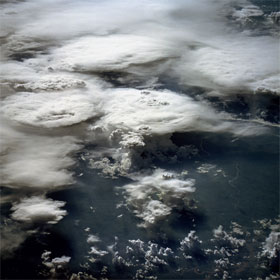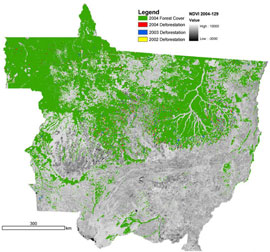Expansion of agriculture in the Amazon may impact climate
Expansion of agriculture in the Amazon may impact climate
mongabay.com
September 19, 2006
A new study from NASA scientists shows that forest clearing for large-scale agriculture has recently become a significant cause of deforestation in the Brazilian Amazon. The researchers warn that this change in land use may affect the region’s climate and the Amazon’s ability to absorb carbon dioxide, a potent greenhouse gas.
The study, published online in the September 14, 2006 edition of the Proceedings of the National Academy of Sciences,
used data from field observations and NASA’s Moderate Resolution Imaging Spectroradiometer (MODIS) to examine cropland expansion in Mato Grosso, the Brazilian state with the highest deforestation and soybean production rates in recent years. The researchers found that in 2003 more than 20 percent of the state’s forests were converted to cropland, suggesting that the recent expansion of mechanized cropland in the region is contributing significantly to deforestation.
The findings confirm the suspicion that Brazil’s soybean production is impacting the Amazon and come several months after a controversial report from Greenpeace which accused fast-food chain McDonald’s of underwriting deforestation in the Amazon through its purchase of soy-based animal derived from soybeans grown in the Amazon Basin. The charges led the company to launch an investigation into Greenpeace’s claims and helped trigger a two-year moratorium by Brazilian soy crushers and exporters on trading soybeans grown on newly deforested lands in the Amazon basin.
Soybeans replace cattle pastures
The latest study found that agricultural plots averaged twice the size of clearings used for pasture and that about 90 percent of new crops were planted within a year of deforestation. Historically, land clearing for pasture has been the dominant cause of forest loss in the Amazon, but in recent years high soybean prices have fueled agricultural expansion in the Amazon basin, especially in the cerrado, a tropical savanna-like ecosystem that neighbors rainforest areas. The researchers found a strong correlation between deforestation and the average annual price of soybeans.
“As soybean prices rose in 2003, the conversion from forest to cropland increased, while the amount of land converted to pasture declined,” note the researchers. “In 2005, soybean prices fell by more than 25 percent and some areas of Mato Grosso showed a decrease in large deforestation events, although the central agricultural zone continued to clear forests,” said study lead author Douglas Morton of the University of Maryland. “But, deforestation rates could return to the high levels seen in 2003 as soybean and other crop prices begin to rebound in international markets.”
The researchers note that commodity prices — especially crops, beef and timber — will likely have a significant impact on future land use and deforestation in the region. Brazil is already one of the world’s largest producers of soybeans and beef.
Shift has ecological and climate impact
The researches say that the development could have significant ecological implications.
“Converting forests to cropland also has a more pronounced ecological and climate impact than other land conversions because it involves the complete removal of land biomass, including tree trunks, stumps and woody roots,” wrote Mike Bettwy of NASA’s Goddard Space Flight Center in a news release. “Of all land uses and types, croplands are… one of the least efficient at absorbing carbon from the air.”
“The carbon once contained in the living material and soil is released into the air from multiple fires during the clearing process, causing atmospheric carbon dioxide concentrations, a primary greenhouse gas, to increase,” added co-author Ruth DeFries of the University of Maryland.
 This photograph, acquired in February 1984 by an astronaut aboard the space shuttle, shows a series of mature thunderstorms located near the Parana River in southern Brazil. Image STS41B-41-2347 was provided by the Earth Sciences and Image Analysis Laboratory at Johnson Space Center.
|
Related research, to be published in Earth Interactions, showed that beyond deforestation, changes in land use also impact the local climate.
“Changes in land cover and use directly influence climate by affecting the amount of solar energy absorbed at the surface, the transfer and flow of heat, and the transport of water from the land and plants through evaporation, a cooling process,” wrote Bettwy. “Model results indicate that areas converted from tropical forest to cropland, including soybean, result in warmer, drier conditions. But the conversion of forest into pasture – land with grasses – results in a cooling effect. Tropical forests generally keep temperatures cooler because they transpire water through their leaves and roots. As a result, forests can maintain the regional climate more readily than croplands, even during the dry season.”
“We found areas deforested and left with bare ground had the most profound impact on climate, raising temperatures up to 3 degrees Fahrenheit,” added study co-author Lahouari Bounoua, a scientist at NASA’s Goddard Space Flight Center. “Forests replaced with croplands had the second most significant climate impact, followed next by pastures.”
The risk of a drier Amazon could be exacerbated by climate change. Computer simulations by the National Center for Atmospheric Research suggest that deforestation could cause surface temperatures to rise 2°C (3.6°F) or more across the Amazon by 2100, producing a significant drop in precipitation and resulting in a drier climate for the region. Declining precipitation could affect levels of rainfall as far away as Texas. A drier Amazon would likely impact agricultural production in the region as well as reducing biodiversity across the Basin.
“This research provides the information needed for programs to reduce deforestation, projections of future deforestation, and efforts to identify priority areas for conservation,” said Morton.
This article is based on a news release from NASA.
